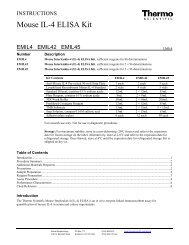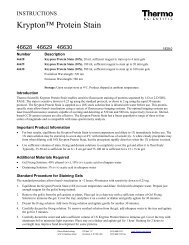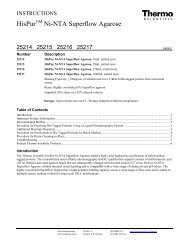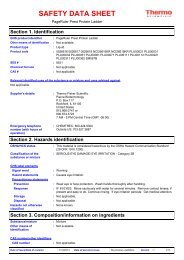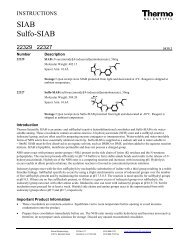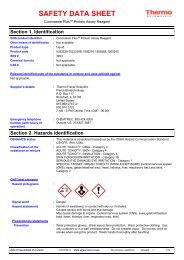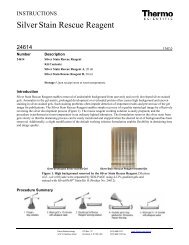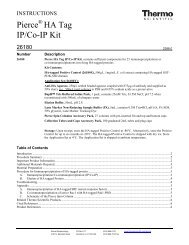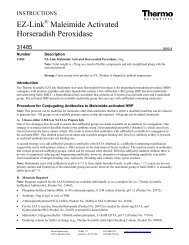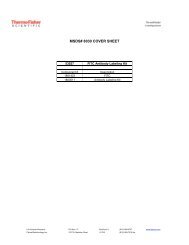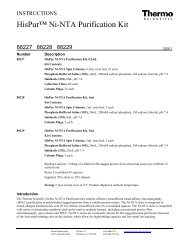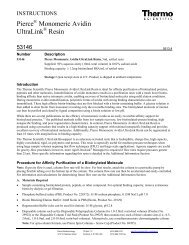EZ-Link Micro NHS-PEG4- Biotinylation Kit - Pierce
EZ-Link Micro NHS-PEG4- Biotinylation Kit - Pierce
EZ-Link Micro NHS-PEG4- Biotinylation Kit - Pierce
You also want an ePaper? Increase the reach of your titles
YUMPU automatically turns print PDFs into web optimized ePapers that Google loves.
INSTRUCTIONS<br />
<strong>EZ</strong>-<strong>Link</strong> <strong>Micro</strong> <strong>NHS</strong>-PEG 4 -<br />
<strong>Biotinylation</strong> <strong>Kit</strong><br />
21955<br />
Number<br />
Description<br />
1790.3<br />
21955 <strong>EZ</strong>-<strong>Link</strong> <strong>Micro</strong> <strong>NHS</strong>-PEG 4 -<strong>Biotinylation</strong> <strong>Kit</strong>, sufficient reagents for approximately 8 labeling<br />
reaction each containing 50-200µg of antibody or other protein in 200-700µL reaction volumes<br />
<strong>Kit</strong> Contents:<br />
<strong>EZ</strong>-<strong>Link</strong> <strong>NHS</strong>-PEG 4 -Biotin, No-Weigh Format, 8 × 2 mg microtubes<br />
Molecular Weight: 588.67<br />
Spacer Arm: 29 Å<br />
BupH Phosphate Buffered Saline Pack, 1 pack, 0.1M sodium phosphate. 0.15M sodium chloride;<br />
pH 7.2 when reconstituted in 500mL of ultrapure water<br />
Zeba Spin Desalting Column, 2mL, 10 columns, for 200-700µL samples, 7000 MWCO<br />
Storage: Upon receipt store microtubes of biotin reagent at -20°C. Store the PBS saline pack at room<br />
temperature. Store the Zeba Desalting Column at 4°C. <strong>Kit</strong> is shipped at ambient temperature.<br />
Table of Contents<br />
Introduction ................................................................................................................................................................................. 1<br />
Important Product Information .................................................................................................................................................... 2<br />
Procedure for Biotinylating Proteins ........................................................................................................................................... 2<br />
A. Calculations ................................................................................................................................................................... 2<br />
B. Biotin-labeling Reaction ................................................................................................................................................ 3<br />
C. Buffer Exchange and Excess Biotin Removal ............................................................................................................... 3<br />
Troubleshooting ........................................................................................................................................................................... 4<br />
Additional Information ................................................................................................................................................................ 4<br />
Related Thermo Scientific Products ............................................................................................................................................ 4<br />
General References ...................................................................................................................................................................... 4<br />
Introduction<br />
The Thermo Scientific <strong>EZ</strong>-<strong>Link</strong> <strong>Micro</strong> <strong>NHS</strong>-PEG 4 -<strong>Biotinylation</strong> <strong>Kit</strong> provides the required reagents for labeling<br />
macromolecules containing primary amino groups and desalting columns for purifying the labeled molecule. The kit is<br />
structured for labeling 50-200µg of protein in 200-700µL. The hydrophilic polyethylene oxide (PEO), also called<br />
polyethylene glycol (PEG), spacer arm imparts water solubility that is transferred to the biotinylated molecule. Consequently,<br />
antibodies labeled with <strong>NHS</strong>-PEG 4 -Biotin exhibit less aggregation when stored in solution compared to antibodies labeled<br />
with reagents having only hydrocarbon spacers. Specific labeling of cell surface proteins is another useful application for this<br />
water-soluble and membrane-impermeable reagent. The Thermo Scientific <strong>NHS</strong>-PEG 4 -Biotin, No-Weigh Format is<br />
packaged in convenient single-use microtubes, eliminating difficulties associated with weighing small quantities of reagent.<br />
Biotin is a small, naturally occurring vitamin that binds with high affinity to avidin and avidin-like proteins. Biotinylated<br />
proteins typically retain biological activity because the biotin group is relatively small. An antibody conjugated with several<br />
biotin molecules can amplify signal, thereby increasing the sensitivity of many assays. The biotin-avidin interaction is rapidly<br />
formed and is unaffected by most extremes of pH, organic solvents and other denaturing agents. Labeled proteins can be<br />
purified using immobilized streptavidin, avidin or Thermo Scientific NeutrAvidin Agarose (see Related Thermo<br />
Scientific Products) and detected in ELISA, dot blot and Western blot applications.<br />
<strong>Pierce</strong> Biotechnology PO Box 117 (815) 968-0747 www.thermoscientific.com/pierce<br />
3747 N. Meridian Road Rockford, lL 61105 USA (815) 968-7316 fax
N-Hydroxysuccinimide (<strong>NHS</strong>) esters are the most popular biotinylation reagents. In pH 7-9 buffers, <strong>NHS</strong> esters react<br />
efficiently with primary amino groups (-NH 2 ) by nucleophilic attack, forming an amide bond and releasing the <strong>NHS</strong> (Figure<br />
1). Proteins typically have many sites for labeling, including the primary amine in the side chain of lysine (K) residues and<br />
the N-terminus of each polypeptide.<br />
Figure 1. Reaction of <strong>NHS</strong>-PEG 4 -Biotin with primary amine. If drawn to scale, the oval representing the protein would be<br />
many times larger than the structures and would likely contain several amino groups. Note that <strong>NHS</strong> is a leaving group<br />
(byproduct) in the reaction. The leaving group and any non-reacted biotin reagent are removed during the desalting step.<br />
Important Product Information<br />
• Use reconstituted <strong>NHS</strong>-PEG 4 -Biotin immediately. The <strong>NHS</strong>-ester moiety readily hydrolyzes and becomes non-reactive;<br />
therefore, do not prepare solutions for storage. Discard any unused reconstituted reagent.<br />
• <strong>NHS</strong>-PEG 4 -Biotin is moisture-sensitive. Immediately before use, puncture the microtube foil with a pipette tip, add<br />
solvent and mix by pipetting up and down. After use, cut off the used microtube and discard. Store the microtube strip at<br />
4-8ºC in the foil pouch provided.<br />
• Avoid buffers containing primary amines (e.g., Tris or glycine), as these will compete with the intended reaction (see<br />
Figure 1). If necessary, dialyze or otherwise desalt to exchange the protein sample into an amine-free buffer such as<br />
phosphate-buffered saline (one packet is included in this kit).<br />
• The desalting columns provided in this kit are best suited for processing biotinylation reactions containing 50-200µg of<br />
protein in approximately 200-700µL. For smaller amounts of protein or reaction volumes, perform both the biotinylation<br />
reaction and buffer exchanges in a single Thermo Scientific Slide-A-Lyzer MINI Dialysis Device (see Additional<br />
Information and Related Thermo Scientific Products). For reaction volumes that are too large for processing with a<br />
desalting column, split the sample between two columns or use an appropriate Slide-A-Lyzer Dialysis Cassette for buffer<br />
exchanges.<br />
• The biotin reagent is first prepared at ~12mg/mL before adding to the reaction mixture. To avoid having to pipette<br />
volumes less than 1µL when biotinylating low protein amounts, dilute the biotin reagent further (e.g., 1:10 dilution). To<br />
minimize hydrolysis in such a dilute solution, dissolve the biotin reagent in either anhydrous DMSO or DMF and make<br />
dilutions with the same solvent.<br />
Procedure for Biotinylating Proteins<br />
A. Calculations<br />
The extent of biotin labeling depends on the size and distribution of amino groups on the protein, protein concentration and<br />
the reagent amount used. Compared to reactions involving concentrated protein solutions, labeling reactions with dilute<br />
protein solutions require a greater fold molar excess of biotin reagent to achieve the same incorporation level. Experiments<br />
that used a 50-fold molar excess of biotin reagent to label 50-200µg antibody (human IgG) for 30 minutes at room<br />
temperature resulted in 1-5 biotin groups per antibody molecule. Adjust the molar ratio of <strong>NHS</strong>-PEG 4 -Biotin to protein to<br />
obtain the desired incorporation level.<br />
<strong>Pierce</strong> Biotechnology PO Box 117 (815) 968-0747 www.thermoscientific.com/pierce<br />
3747 N. Meridian Road Rockford, lL 61105 USA (815) 968-7316 fax<br />
2
1. Calculate millimoles of <strong>NHS</strong>-PEG 4 -Biotin to add to the reaction for a 50-fold molar excess:<br />
mg protein mmol protein 50 mmol Biotin<br />
mL protein ×<br />
×<br />
×<br />
= mmol Biotin<br />
mL protein mg protein mmol protein<br />
• 50 = Recommended molar fold excess of biotin per protein sample<br />
2. Calculate microliters of 20mM <strong>NHS</strong>-PEG 4 -Biotin (prepared in Step B.3) to add to the reaction:<br />
589 mg 170 μL<br />
mmol Biotin ×<br />
× = μL Biotin Solution<br />
mmol Biotin 2.0 mg<br />
• 589 = Molecular weight of <strong>NHS</strong>-PEG 4 -Biotin<br />
• 170 = <strong>Micro</strong>liters of solvent in which 2.0mg of <strong>NHS</strong>-PEG 4 -Biotin is dissolved to make 20mM<br />
Example: For 0.7mL of a 0.29mg/mL IgG (150,000 MW) solution, 3µL of 20mM <strong>NHS</strong>-PEG 4 -Biotin will be added.<br />
0.29 mg IgG 1mmol IgG 50 mmol Biotin<br />
0.7 mL IgG ×<br />
×<br />
×<br />
= 0.0000676 mmol Biotin<br />
1mL IgG 150,000 mg IgG 1mmol IgG<br />
589 mg 170 μL<br />
0.0000676 mmol Biotin ×<br />
× = 3.4 μL Biotin Solution<br />
mmol Biotin 2.0 mg<br />
B. Biotin-labeling Reaction<br />
1. Dissolve 50-200µg of protein in 200-700µL of phosphate-buffered saline (PBS) according to the calculation made in<br />
Section A. Prepare the Thermo Scientific BupH PBS as directed on the package label.<br />
Note: Protein already dissolved in amine-free buffer at pH 7.2-8.0 may be used without buffer exchange. Proteins in Tris<br />
or other amine-containing buffers must be exchanged into PBS. Perform buffer exchange of 200-700µL samples by<br />
dialysis or using a desalting column included in this kit. This kit contains 10 single-use desalting columns and eight<br />
microtubes of biotin reagent. Two columns may be used for buffer exchange, but the remaining eight columns are<br />
needed to remove excess biotin reagent after performing the biotinylation reaction for each of the eight reactions.<br />
2. Cut off one microtube of <strong>NHS</strong>-PEG 4 -Biotin from the No-Weigh <strong>Micro</strong>tube Strip. Return the unused strip of microtubes<br />
to its pouch and store desiccated at 4ºC.<br />
3. With a pipette tip, puncture the foil top on the biotin reagent microtube. To prepare 20mM, add 170µL of solvent (e.g.,<br />
water, PBS, DMF or DMSO; see the Important Product Information Section) to the tube and mix by pipetting up and<br />
down.<br />
4. Add the appropriate volume of <strong>NHS</strong>-PEG 4 -Biotin solution (see calculations in Section A) to the protein solution.<br />
5. Incubate the reaction on ice for two hours or at room temperature for 30-60 minutes. There is no harm in reacting longer<br />
than the specified time other than the possibility of ordinary protein degradation or microbial growth.<br />
Note: Although excess non-reacted and hydrolyzed biotin reagent remains in the solution, it is often possible to perform<br />
preliminary tests of the labeled protein by ELISA or Western blot. Once function has been confirmed, buffer exchange<br />
the labeled protein for optimal performance and stability using the procedure in Section C.<br />
C. Buffer Exchange and Excess Biotin Removal<br />
1. Prepare a Zeba Spin Desalting Column by breaking off the bottom plug and placing the column into a 15mL collection<br />
tube. Centrifuge the column at 1000 × g for 2 minutes, discard the storage buffer and return column to the same<br />
collection tube. Place a mark on the side of the column where the compacted resin is slanted upward. Place column in<br />
centrifuge with the mark facing outward in all subsequent centrifugation steps.<br />
2. Equilibrate the column by adding 1mL of PBS to the top of the resin bed and centrifuging at 1000 × g for 2 minutes.<br />
Discard the flow-through and repeat this step 2-3 times.<br />
3. Place column into a new 15mL collection tube and apply protein sample directly onto the center of the resin bed. Allow<br />
sample to absorb into the resin.<br />
Note: For samples < 400µL, add 100µL ultrapure water stacker on top of the absorbed sample to maximize recovery.<br />
<strong>Pierce</strong> Biotechnology PO Box 117 (815) 968-0747 www.thermoscientific.com/pierce<br />
3747 N. Meridian Road Rockford, lL 61105 USA (815) 968-7316 fax<br />
3
4. Centrifuge the column at 1000 × g for 2 minutes. The collected flow-through solution is the purified protein sample.<br />
Store the protein solution in appropriate conditions.<br />
Troubleshooting<br />
Problem Possible Cause Solution<br />
Lack of biotinylation No amines available on molecule of<br />
interest<br />
Use a biotinylation reagent that targets a different<br />
functional group or convert sulfhydryl to amine<br />
using Aminoethyl-8 (Product No. 23010)<br />
Buffer contained primary amines Use a non-amine-containing buffer<br />
Reagent was not reactive; caused by Use reagent immediately upon reconstitution<br />
hydrolysis of the <strong>NHS</strong> ester<br />
Not enough biotin reagent was added to<br />
the reaction mixture<br />
Increase the molar excess of biotin reagent to<br />
protein<br />
Low level of biotinylation Carrier protein was added to purified<br />
IgG to help stabilize it<br />
Remove carrier protein before biotinylation to<br />
reduce competition for labeling<br />
Protein is non-functional Excessive biotinylation Reduce the molar excess of biotinylation reagent,<br />
or reduce time or temperature for biotinylation<br />
Low protein recovery after No stacker used<br />
Apply a stacker above sample<br />
desalting<br />
Unstable protein<br />
Equilibrate column in a suitable buffer<br />
Additional Information<br />
Please visit the website for additional information including the following:<br />
• Tech Tip #14: Perform labeling and other reactions in Slide-A-Lyzer Dialysis Cassettes<br />
• Tech Tip #43: Protein stability and storage<br />
Related Thermo Scientific Products<br />
21925 <strong>EZ</strong>-<strong>Link</strong> <strong>Micro</strong> Sulfo-<strong>NHS</strong>-<strong>Biotinylation</strong> <strong>Kit</strong><br />
21326 <strong>EZ</strong>-<strong>Link</strong> Sulfo-<strong>NHS</strong>-Biotin, No-Weigh Format, 8 × 1mg microtubes<br />
21935 <strong>EZ</strong>-<strong>Link</strong> <strong>Micro</strong> Sulfo-<strong>NHS</strong>-LC-<strong>Biotinylation</strong> <strong>Kit</strong><br />
21327 <strong>EZ</strong>-<strong>Link</strong> Sulfo-<strong>NHS</strong>-LC-Biotin, No-Weigh Format, 8 × 1mg microtubes<br />
21445 <strong>EZ</strong>-<strong>Link</strong> Sulfo-<strong>NHS</strong>-SS-<strong>Biotinylation</strong> <strong>Kit</strong><br />
21328 <strong>EZ</strong>-<strong>Link</strong> Sulfo-<strong>NHS</strong>-SS-Biotin, No-Weigh Format, 8 × 1mg microtubes<br />
21945 <strong>EZ</strong>-<strong>Link</strong> <strong>Micro</strong> Sulfo-<strong>NHS</strong>-SS-<strong>Biotinylation</strong> <strong>Kit</strong><br />
21329 <strong>EZ</strong>-<strong>Link</strong> <strong>NHS</strong>-PEG 4 -Biotin, No-Weigh Format, 8 × 2mg microtubes<br />
20347 <strong>Pierce</strong> Streptavidin Agarose Resin, 2mL<br />
General References<br />
Ali, M.K. and Bergson, C. (2003). Elevated intracellular calcium triggers recruitment of the receptor cross-talk accessory protein calcyon to the plasma<br />
membrane. J Biol Chem 278(51):51654-63.<br />
Boroto, A., et al. (2003). Impaired trafficking and activation of tumor necrosis factor-alpha-converting enzyme in cell mutants defective in protein<br />
ectodomain shedding. J Biol Chem 278(28):25933-9.<br />
Chyung, J.H. and Selkoe, D.J. (2003). Inhibition of receptor-mediated endocytosis demonstrates generation of amyloid beta-protein at the cell surface. J Biol<br />
Chem 278(51):51035-43.<br />
Frickel, E-M., et al. (2002). TROSY-NMR reveals interaction between Erp57 and the tip of the calreticulin P-domain. PNAS 99(4):1954-9.<br />
Li, H. and Pajor, A.M. (2003). Mutagenesis of the N-glycosylation site of hNaSi-1 reduces transport activity. Am J Physiol Cell Physiol 285:C1188-96.<br />
Ohnishi, T., et al. (2003). MD-2 is necessary for the toll-like receptor 4 protein to undergo glycosylation essential for its translocation to the cell surface.<br />
Clin Diagn Lab Immunol 10(3):405-10.<br />
<strong>Pierce</strong> Biotechnology PO Box 117 (815) 968-0747 www.thermoscientific.com/pierce<br />
3747 N. Meridian Road Rockford, lL 61105 USA (815) 968-7316 fax<br />
4
Products are warranted to operate or perform substantially in conformance with published Product specifications in effect at the time of sale, as set forth in<br />
the Product documentation, specifications and/or accompanying package inserts (“Documentation”). No claim of suitability for use in applications regulated<br />
by FDA is made. The warranty provided herein is valid only when used by properly trained individuals. Unless otherwise stated in the Documentation, this<br />
warranty is limited to one year from date of shipment when the Product is subjected to normal, proper and intended usage. This warranty does not extend to<br />
anyone other than Buyer. Any model or sample furnished to Buyer is merely illustrative of the general type and quality of goods and does not represent that<br />
any Product will conform to such model or sample.<br />
NO OTHER WARRANTIES, EXPRESS OR IMPLIED, ARE GRANTED, INCLUDING WITHOUT LIMITATION, IMPLIED WARRANTIES OF<br />
MERCHANTABILITY, FITNESS FOR ANY PARTICULAR PURPOSE, OR NON INFRINGEMENT. BUYER’S EXCLUSIVE REMEDY FOR NON-<br />
CONFORMING PRODUCTS DURING THE WARRANTY PERIOD IS LIMITED TO REPAIR, REPLACEMENT OF OR REFUND FOR THE NON-<br />
CONFORMING PRODUCT(S) AT SELLER’S SOLE OPTION. THERE IS NO OBLIGATION TO REPAIR, REPLACE OR REFUND FOR PRODUCTS<br />
AS THE RESULT OF (I) ACCIDENT, DISASTER OR EVENT OF FORCE MAJEURE, (II) MISUSE, FAULT OR NEGLIGENCE OF OR BY BUYER,<br />
(III) USE OF THE PRODUCTS IN A MANNER FOR WHICH THEY WERE NOT DESIGNED, OR (IV) IMPROPER STORAGE AND HANDLING OF<br />
THE PRODUCTS.<br />
Unless otherwise expressly stated on the Product or in the documentation accompanying the Product, the Product is intended for research only and is not to<br />
be used for any other purpose, including without limitation, unauthorized commercial uses, in vitro diagnostic uses, ex vivo or in vivo therapeutic uses, or<br />
any type of consumption by or application to humans or animals.<br />
Current product instructions are available at www.thermoscientific.com/pierce. For a faxed copy, call 800-874-3723 or contact your local distributor.<br />
© 2013 Thermo Fisher Scientific Inc. All rights reserved. Unless otherwise indicated, all trademarks are property of Thermo Fisher Scientific Inc. and its<br />
subsidiaries. Printed in the USA.<br />
<strong>Pierce</strong> Biotechnology PO Box 117 (815) 968-0747 www.thermoscientific.com/pierce<br />
3747 N. Meridian Road Rockford, lL 61105 USA (815) 968-7316 fax<br />
5



